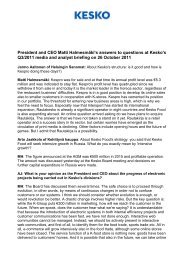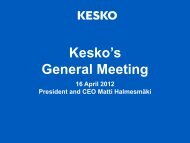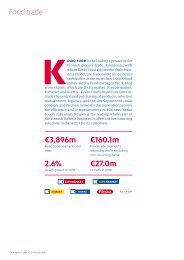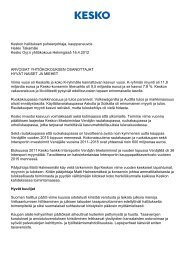Create successful ePaper yourself
Turn your PDF publications into a flip-book with our unique Google optimized e-Paper software.
120 <strong>Kesko's</strong> <strong>year</strong> <strong>2007</strong><br />
Note 44<br />
Financial risk management<br />
Financial risk management<br />
With respect to financial risks, the Group observes a uniform funding<br />
policy that has been approved by the company's Board of Directors. Compliance<br />
with this policy and developments in the Group's financial situation<br />
are monitored by the Audit Committee of the Board of Directors. The<br />
policy covers the sectors for which Corporate Treasury holds central<br />
responsibility, namely Group funding, liquidity management, bank relations<br />
and the management of financial risks. In the main, the Group's<br />
funding is arranged through the parent company, and the Corporate<br />
Treasury arranges intra-Group loans for the funding of subsidiaries in<br />
their local currencies. For companies with significant external ownership,<br />
the Group has not guaranteed financial liabilities in excess of its<br />
ownership interest.<br />
Currency risk and sensitivity analysis<br />
The Group's balance sheet is exposed to translation risks in connection<br />
with investments in subsidiaries outside the eurozone. This balance<br />
sheet exposure has been hedged by using currency-denominated loans<br />
and forward fx agreements if the translation risk is in excess of €1 million.<br />
The most significant balance sheet exposure positions are in Estonian<br />
kroon, Norwegian krone, Swedish krona, Russian rouble, Lithuanian<br />
lit and Latvian lat.<br />
The Group has not hedged foreign currency denominated goodwill<br />
(incl. allocated goodwill) with a counter value of €112.4 million (€105.6<br />
million) at 31 December <strong>2007</strong>.<br />
The currency risk exposed to translation risk, excluding foreign-currency-denominated<br />
goodwill, is small in proportion to the volume of<br />
operations and the balance sheet total. A simultaneous 10% weakening<br />
of the six central currencies (NOK, EEK, LTL, RUB, LVL, SEK) against the<br />
euro would result in a €4.6 million negative change in equity at 31<br />
December <strong>2007</strong> (€7.3 million).<br />
Translation risk and hedging at 31 December <strong>2007</strong><br />
€ million Latvia Norway Estonia Sweden Russia Lithuania Others Total<br />
Equity exposed to translation risk*) 7.9 27.2 78.6 3.0 21.0 39.8 7.9 185.4<br />
Hedging derivatives 3.6 37.7 5.3 18.9 13.8 79.3<br />
Hedging loans 2.2 22.6 25.9 9.8 60.5<br />
Open position 2.1 4.6 15.0 -2.3 2.1 16.2 7.9 45.6<br />
*) equity excl. allocated goodwill<br />
Translation risk and hedging at 31 December 2006<br />
€ million Latvia Norway Estonia Sweden Russia Lithuania Others Total<br />
Equity exposed to translation risk*) 7.6 42.6 39.1 9.3 18.8 29.5 4.1 151.0<br />
Hedging derivatives 2.9 9.7 2.2 8.7 15.9 39.4<br />
Hedging loans 24.3 9.6 4.3 38.2<br />
Open position 4.7 8.6 29.5 7.1 10.1 9.3 4.1 73.4<br />
*) equity excl. allocated goodwill<br />
Kesko Corporation's USD-denominated private placement loan has<br />
been hedged against currency risk and interest rate risk by applying<br />
hedge accounting. Currency and interest rate swaps in the same amount<br />
and maturity as the loan have been designated as the hedging instruments.<br />
Consequently, the loan is entirely hedged against currency and<br />
interest rate risk. During the period, no amount of ineffectiveness has<br />
been recognised in the income statement relating to this credit facility.<br />
International purchasing activity exposes the Group to transaction<br />
risks relating to several foreign currencies. Due to the fast turnover of<br />
some products, the exposure related to their purchases cannot grow to a<br />
significant level because the selling prices of these products can be<br />
changed as necessary. The percentage of hedging is decided by the subsidiaries<br />
and business units concerned. Transaction risk exposures<br />
mainly relate to the US dollar. Business units carry out their hedging<br />
operations together with Corporate Treasury, which hedges risk positions<br />
using market transactions within the limits confirmed for each currency.<br />
A sensitivity analysis for the currency risk relating to the USD, prepared<br />
in compliance with IFRS 7, would have contributed a pre-tax profit<br />
of €+/-0.4 million (€+/-0.7 million) at the balance sheet date of 31 December<br />
<strong>2007</strong>, had the USD rate change been +/-10%. It is assumed that the<br />
other variables remain unchanged. The calculation includes foreign currency<br />
denominated trade payables, trade receivables and currency derivatives<br />
recognised in the balance sheet. Their combined net position totals<br />
€6.4 million (€9.7 million). The analysis does not consider the foreign<br />
currency denominated orders, some of which are also hedged.<br />
The Group's foreign subsidiaries also buy currency independently for<br />
commercial purchases. Such purchases do not, however, constitute a significant<br />
proportion of total purchases.<br />
The Group does not apply hedge accounting in accordance with IAS<br />
39 to hedge commercial currency risks. In initial recognition, derivative<br />
instruments are recorded at fair value and at subsequent measurement<br />
they are recognised at fair value. Value changes of currency derivatives<br />
used to hedge purchases and sales are recognised in other operating<br />
income or expenses.<br />
The Group companies are financed in the local currency of each company.<br />
The parent company hedges against related foreign currency risks















